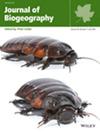Landscape Evolution Drives Continental Diversification in Neotropical Freshwater Fishes of the Family Erythrinidae (Teleostei, Characiformes)
Abstract
Aim
Evolutionary diversification and diversity patterns in Neotropical freshwater fishes can be predicted, in part, by the effects of geomorphological settings and landscape evolution. However, studies at a continental scale, focusing on specific taxa that reflect the tight connection between their evolutionary history and orogenic uplifts on the tectonically active Western margin and watershed migration dynamics on the passive Eastern margin of South America remain limited. Here, we investigated biogeographical and chronological patterns of diversification in the geographically widespread teleost family Erythrinidae (Characiformes, Erythrinoidea).
Location
Neotropical Region.
Time Period
Late Cretaceous and Cenozoic.
Taxon
Erythrinidae (Characiformes).
Methods
We used phylogenomic and parametric biogeographic methods. Our dataset based on ultraconserved elements (UCEs) included 29 erythrinoid lineages and 23 related taxa.
Results
The time calibration along with ancestral area estimation proposes that superfamily Erythrinoidea originated in the Late Cretaceous ca. 80 Ma, with divergence of major clades during the Palaeogene ca. 51–31 Ma. Erythrinidae diversified rapidly after the formation of the transcontinental Amazon River ca. 10 Ma, from 8 lineages to at least 28 putative species today. A majority of erythrinid species (78%) are members of just three relatively young clades less than 13 Ma: Erythrinus, Hoplerythrinus and Hoplias malabaricus species group. Results present contrasting temporal patterns of cladogenetic events on the two continental margins: a pulsed-age distribution of biogeographic events on the Western Margin as predicted by discrete tectonic uplifts of the Northern Andean cordilleras, and a more continuous age distribution on the Eastern Margin as predicted by westwards-propagating watershed migration.
Main Conclusions
Historical changes in landscape connectivity have influenced diversification in Erythrinidae, where Late Neogene uplifts of the Northern Andean cordilleras profoundly structured freshwater diversity gradients by fragmenting the aquatic faunas of cis- and trans-Andean basins as well as portions of the sub-Andean Foreland basin, and merging faunas of the Western and Eastern Amazonia with the onset of the transcontinental Amazon River. Alternative diversification scenarios are also consistent with available palaeontological, palaeogeographical and palaeoenvironmental data.

 求助内容:
求助内容: 应助结果提醒方式:
应助结果提醒方式:


